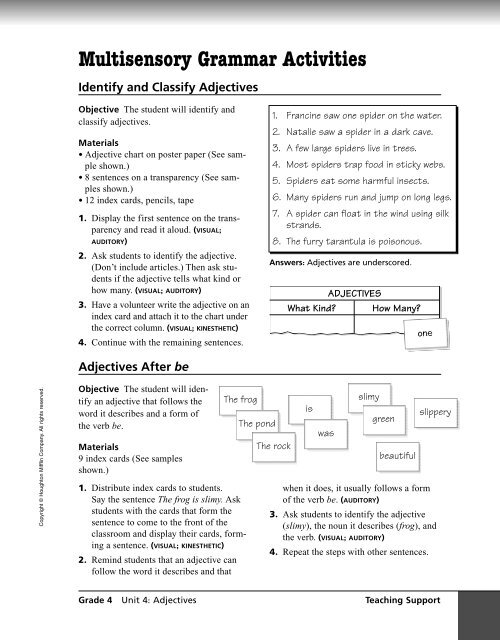Multisensory Grammar Activities - Houghton Mifflin Harcourt
Multisensory Grammar Activities - Houghton Mifflin Harcourt
Multisensory Grammar Activities - Houghton Mifflin Harcourt
You also want an ePaper? Increase the reach of your titles
YUMPU automatically turns print PDFs into web optimized ePapers that Google loves.
Copyright © <strong>Houghton</strong> <strong>Mifflin</strong> Company. All rights reserved.<br />
<strong>Multisensory</strong> <strong>Grammar</strong> <strong>Activities</strong><br />
Identify and Classify Adjectives<br />
Objective The student will identify and<br />
classify adjectives.<br />
Materials<br />
• Adjective chart on poster paper (See sample<br />
shown.)<br />
• 8 sentences on a transparency (See samples<br />
shown.)<br />
• 12 index cards, pencils, tape<br />
1. Display the first sentence on the transparency<br />
and read it aloud. (VISUAL;<br />
AUDITORY)<br />
2. Ask students to identify the adjective.<br />
(Don’t include articles.) Then ask students<br />
if the adjective tells what kind or<br />
how many. (VISUAL; AUDITORY)<br />
3. Have a volunteer write the adjective on an<br />
index card and attach it to the chart under<br />
the correct column. (VISUAL; KINESTHETIC)<br />
4. Continue with the remaining sentences.<br />
Adjectives After be<br />
Objective The student will identify<br />
an adjective that follows the<br />
word it describes and a form of<br />
the verb be.<br />
Materials<br />
9 index cards (See samples<br />
shown.)<br />
The frog<br />
1. Distribute index cards to students.<br />
Say the sentence The frog is slimy. Ask<br />
students with the cards that form the<br />
sentence to come to the front of the<br />
classroom and display their cards, forming<br />
a sentence. (VISUAL; KINESTHETIC)<br />
2. Remind students that an adjective can<br />
follow the word it describes and that<br />
The pond<br />
1. Francine saw one spider on the water.<br />
2. Natalie saw a spider in a dark cave.<br />
3. A few large spiders live in trees.<br />
4. Most spiders trap food in sticky webs.<br />
5. Spiders eat some harmful insects.<br />
6. Many spiders run and jump on long legs.<br />
7. A spider can float in the wind using silk<br />
strands.<br />
8. The furry tarantula is poisonous.<br />
Answers: Adjectives are underscored.<br />
The rock<br />
ADJECTIVES<br />
What Kind? How Many?<br />
beautiful<br />
when it does, it usually follows a form<br />
of the verb be. (AUDITORY)<br />
3. Ask students to identify the adjective<br />
(slimy), the noun it describes (frog), and<br />
the verb. (VISUAL; AUDITORY)<br />
4. Repeat the steps with other sentences.<br />
slippery<br />
Grade 4 Unit 4: Adjectives Teaching Support<br />
is<br />
was<br />
slimy<br />
green<br />
one
<strong>Multisensory</strong> <strong>Grammar</strong> <strong>Activities</strong> continued<br />
Using a or an<br />
Objective The student will use the articles<br />
a and an correctly.<br />
Materials<br />
• Pencils and paper<br />
• Chalk<br />
1. Have students select an item from somewhere<br />
in the classroom and bring it to<br />
their desks. (KINESTHETIC)<br />
2. Ask a volunteer to display and name his<br />
or her item. Have the student write the<br />
name of the item on the chalkboard and<br />
circle the first letter of the word. (VISUAL;<br />
AUDITORY; KINESTHETIC)<br />
3. Ask students whether the item name begins<br />
with a vowel or consonant sound.<br />
Remind students that words beginning<br />
with a vowel sound use an. Then have<br />
the volunteer write the correct article before<br />
the item name. (AUDITORY; VISUAL;<br />
KINESTHETIC)<br />
Comparing with good and bad<br />
Objective The student will use the correct<br />
forms of good and bad when making<br />
comparisons.<br />
Materials<br />
• Game board (See sample shown.)<br />
• 1 number cube for each pair of students<br />
1. Divide students into pairs. Make a game<br />
board and give a copy to each pair.<br />
2. Each student rolls the number cube. The<br />
player with the higher number goes first.<br />
3. Students play ticktacktoe with forms of<br />
good and bad. Player 1 chooses a square<br />
and says a sentence using the word in the<br />
square correctly. If the sentence is correct,<br />
the player marks the square with an<br />
a jacket<br />
an eraser<br />
4. Continue until all students have shared<br />
their items.<br />
5. Have students choose five items and<br />
write a sentence for each one, using the<br />
correct article. (VISUAL; KINESTHETIC)<br />
good better best<br />
bad worse worst<br />
better worse best<br />
X or an O. If students are undecided<br />
about a sentence, have them refer to the<br />
pupil edition or ask the teacher. (AUDI-<br />
TORY; VISUAL; KINESTHETIC)<br />
4. Play continues until the one player has<br />
marked three squares in a row with X’s<br />
or O’s.<br />
Teaching Support Grade 4 Unit 4: Adjectives<br />
Copyright © <strong>Houghton</strong> <strong>Mifflin</strong> Company. All rights reserved.


